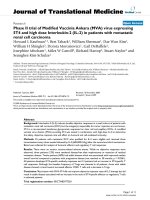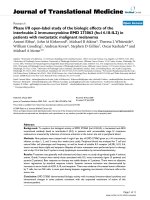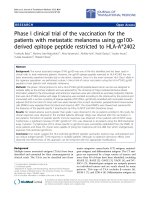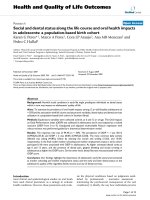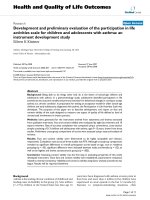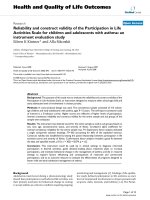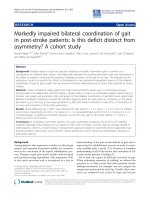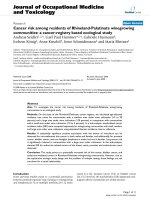báo cáo hóa học:" Phase I/II open-label study of the biologic effects of the interleukin-2 immunocytokine EMD 273063 (hu14.18-IL2) in patients with metastatic malignant melanoma" docx
Bạn đang xem bản rút gọn của tài liệu. Xem và tải ngay bản đầy đủ của tài liệu tại đây (497 KB, 11 trang )
BioMed Central
Page 1 of 11
(page number not for citation purposes)
Journal of Translational Medicine
Open Access
Research
Phase I/II open-label study of the biologic effects of the
interleukin-2 immunocytokine EMD 273063 (hu14.18-IL2) in
patients with metastatic malignant melanoma
Antoni Ribas
1
, John M Kirkwood
2
, Michael B Atkins
3
, Theresa L Whiteside
4
,
William Gooding
5
, Andreas Kovar
6
, Stephen D Gillies
7
, Oscar Kashala*
8
and
Michael A Morse*
9
Address:
1
University of California, 11-934 Factor Building, UCLA Medical Center, 10833 Le Conte Avenue, Los Angeles, CA 90095-1782, USA,
2
University of Pittsburgh Cancer Institute, University of Pittsburgh Medical Center, Hillman Cancer Center, 5115 Centre Avenue, Pittsburgh, PA
15232, USA,
3
Division of Hematology/Oncology Beth Israel Deaconess Medical Center, MASCO 412, 375 Longwood Ave, Boston, MA 02215,
USA,
4
University of Pittsburgh Cancer Institute, University of Pittsburgh Medical Center, Hillman Cancer Center, 5117 Centre Avenue, Suite 1.27,
Pittsburgh, PA 15213, USA,
5
University of Pittsburgh Cancer Institute, Biostatistics Facility, Suite 325 Sterling Plaza, 201 North Craig Street,
Pittsburgh, PA 15213, USA,
6
Merck KGaA, Frankfurter Str. 250, F135/129, D-64293 Darmstadt, Germany,
7
Provenance Biopharmaceuticals Corp.,
830 Winter Street, Waltham, MA 02451, USA,
8
EMD Serono, Inc., One Technology Place, Rockland, MA 02370, USA and
9
Duke University Medical
Center, MSRB Room 433, Box 3233, Research Drive, Durham, NC 27710, USA
Email: Antoni Ribas - ; John M Kirkwood - ; Michael B Atkins - ;
Theresa L Whiteside - ; William Gooding - ; Andreas Kovar - ;
Stephen D Gillies - ; Oscar Kashala* - ; Michael A Morse* -
* Corresponding authors
Abstract
Background: To explore the biological activity of EMD 273063 (hu14.18-IL2), a humanized anti-GD2
monoclonal antibody fused to interleukin-2 (IL2), in patients with unresectable, stage IV cutaneous
melanoma as measured by induction of immune activation at the tumor site and in peripheral blood.
Methods: Nine patients were treated with 4 mg/m
2
per day of EMD 273063 given as a 4-h intravenous
infusion on days 1, 2, and 3 every four weeks (one cycle). Peripheral blood was analyzed for T cell and
natural killer cell phenotype and frequency, as well as levels of soluble IL2 receptor (sIL2R), IL10, IL6,
tumor necrosis factor alpha and neopterin. Biopsies of tumor metastasis were performed prior to therapy
and at day 10 of the first 2 cycles to study lymphocyte accumulation by immunohistochemistry.
Results: Treatment was generally well tolerated and there were no study drug-related grade 4 adverse
events. Grade 3 events were mainly those associated with IL2, most commonly rigors (3 patients) and
pyrexia (2 patients). Best response on therapy was stable disease in 2 patients. There were no objective
tumor regressions by standard response criteria. Systemic immune activation was demonstrated by
increases in serum levels of sIL2R, IL10, and neopterin. There was evidence of increased tumor infiltration
by T cells, but not NK cells, in most post-dosing biopsies, suggesting recruitment of immune cells to the
tumor site.
Conclusion: EMD 273063 demonstrated biologic activity with increased immune-related cytokines and
intratumoral changes in some patients consistent with the suspected mechanism of action of this
immunocytokine.
Published: 29 July 2009
Journal of Translational Medicine 2009, 7:68 doi:10.1186/1479-5876-7-68
Received: 8 May 2009
Accepted: 29 July 2009
This article is available from: />© 2009 Ribas et al; licensee BioMed Central Ltd.
This is an Open Access article distributed under the terms of the Creative Commons Attribution License ( />),
which permits unrestricted use, distribution, and reproduction in any medium, provided the original work is properly cited.
Journal of Translational Medicine 2009, 7:68 />Page 2 of 11
(page number not for citation purposes)
Background
Interleukin-2 (IL2) is one of the three drugs currently
approved by the U.S. Food and Drug Administration
(FDA) for the treatment of metastatic melanoma. High
dose IL2 induces tumor response rates of approximately
15% in patients with metastatic melanoma, with nearly
half of these responses being extremely durable and lead-
ing to a seemingly cured subset of patients [1,2]. The main
drawback of IL2 therapy is its toxicity, especially when
administered at high doses that require hospitalization for
therapy. Most patients receiving the FDA-approved high
dose IL2 experience reversible grade 3 and 4 toxicities
including hypotension, renal insufficiency, pulmonary
edema, and cardiac arrhythmias with frequent need for
continuous cardiac monitoring and administration of
vasopressors such as dopamine and phenylephrine.
We hypothesized that targeted delivery of IL2 to the tumor
microenvironment using immunocytokines would limit
toxicity and increase efficacy of IL2-based therapies.
Immunocytokines are genetically engineered fusion pro-
teins consisting of a monoclonal antibody directed
against a cancer cell surface antigen and a cytokine such as
IL2 [3]. The immunocytokine EMD 273063 (hu14.18-
IL2) consists of two molecules of human recombinant IL2
genetically linked to a humanized monoclonal antibody,
which is directed against the diasiologanglioside GD2
(hu14.18). GD2 is a carbohydrate antigen found on the
surface of human neuroectodermally-derived tumors
including melanomas, neuroblastomas and some sarco-
mas [4]. Therefore, GD2 represents a target for the poten-
tial delivery of IL2 to the tumor site [3]. The
immunocytokine is expected to maintain the activities of
the monoclonal antibody that include target cell binding,
effector functions such as complement-dependent cyto-
toxicity (CDC) and antibody-dependent cellular cytotox-
icity (ADCC), while possessing cytokine function. The
locally delivered IL2 may activate T and natural killer
(NK) cells, which could release a secondary wave of
cytokines, and activate immune effector cells.
In animal models, EMD 273063 was able to completely
eradicate established lung, liver, subcutaneous, and bone
marrow metastases of melanoma and neuroblastoma in
immunocompetent mice bearing syngeneic tumor cells
transfected to express the GD2 molecule (melanoma
model), and in SCID mice reconstituted with human lym-
phokine-activated killer (LAK) cells and bearing human
tumor xenografts (neuroblastoma) [5]. Interestingly,
CD8+ T cells were required for activity of this immunocy-
tokine in melanoma (but not in neuroblastoma),
although the melanoma antigens recognized by these
CD8+ T cells were not identified. Furthermore, the antitu-
mor activity was dependent on the intact immunocy-
tokine, since it could not be replicated by the
administration of equivalent mixtures of antibody and
IL2 [6].
EMD 273063 was tested in a phase I clinical trial aimed at
evaluating its safety, toxicity and in vivo immunological
effects in 33 patients with metastatic melanoma [7]. This
immunocytokine was given as a 4-h intravenous infusion
on days 1, 2 and 3 of week 1 at dose levels of 0.8–7.5 mg/
m
2
per day every 4 weeks (one cycle). The best response on
study was stable disease for at least 2 cycles of therapy in
8 patients. Dose-limiting toxicities defining the maximum
tolerable dose (MTD) of 7.5 mg/m
2
per day included
hypoxia, hypotension, and elevations in liver function
tests. Immune activation was induced, as measured by
rebound lymphocytosis, increased peripheral-blood NK
cell number and activity, and increased serum levels of the
soluble alpha chain of the IL2 receptor complex (sIL2R),
which was observed at doses both higher (4.8 mg/m
2
per
day) and lower (3.2 mg/m
2
per day) than the dose
selected for evaluation in the current study. These results
were replicated in a separate phase I clinical trial in a pedi-
atric population of patients with neuroblastoma (27 sub-
jects) and melanoma (one subject) treated with EMD
273063 [8]. Evidence of immune activation was based on
increases in serum levels of sIL2R and rebound lymphocy-
tosis. There were no major objective tumor responses, but
some patients with chemotherapy-refractory neuroblast-
oma had periods of durable disease stabilization. In this
population, the MTD of EMD 273063 was determined to
be 12 mg/m
2
per day.
We hypothesized that the augmented immune activation
detectable in peripheral blood after administration of
EMD 273063 would be associated with enhanced
immune cell infiltrates in melanoma lesions. Therefore,
we performed this study to estimate the biologic effects of
EMD 273063 at 4 mg/m
2
per day for 3 days as measured
by the induction of immune activation in peripheral
blood and at the tumor site in a pilot group of patients.
The dose of 4 mg/m
2
was chosen for further clinical eval-
uation because the toxicity increased with higher doses in
the prior phase I/II clinical trials, whereas there was evi-
dence of reproducible immune activation at this dose
level [7,8].
Methods
Study design and endpoints
Study EMR 62207-005 was a phase I/II, open-label, multi-
center (4 centers in the USA) clinical trial. Prior to study
initiation, the protocol and informed consent documents
were approved by the Institutional Review Boards at each
study center, and the study was conducted in accordance
with both the provisions of the Declaration of Helsinki
and Good Clinical Practice. Site monitoring included
review of the accuracy of the data in the case report forms.
Journal of Translational Medicine 2009, 7:68 />Page 3 of 11
(page number not for citation purposes)
The study planned to enroll 12 eligible patients to explore
the effect of EMD 273063 on the study endpoints. This
number was based on previous experience with immune
analyses indicating that relevant immune responses could
be detected with 9–12 patients. This clinical trial was not
powered to make inferential statistical analyses. The pri-
mary study objective was to estimate the biological activ-
ity of EMD 273063 as measured by induction of immune
activation in peripheral blood and at the tumor site. Sec-
ondary objectives were clinical anti-tumor activity, safety,
toxicity and pharmacokinetics (PK) of EMD 273063. Tox-
icity grades were classified according to the NCI Common
Toxicity Criteria Version 2. Objective tumor responses
were assessed by the investigators using Response Evalua-
tion Criteria in Solid Tumors (RECIST) [9].
Patient selection
Eligible patients had histopathologically confirmed stage
IV cutaneous melanoma that was not amenable to surgi-
cal treatment with curative intent, had progressed after
prior therapy including IL2 and/or interferon (IFN), had a
Karnofsky performance status of ≥ 70%, and had ade-
quate organ function. Patients were enrolled at least 4
weeks after their last dose of prior therapy. Patients were
to have at least 4 melanoma lesions (other than a target
lesion) available for outpatient biopsies. The inclusion
criteria initially required that the patients be HLA-A2-pos-
itive to allow for the assessment of CD8 responses to HLA-
A2-restricted melanoma peptides. This criterion was later
modified to enhance enrolment. GD2 expression by
tumor cells was not an eligibility criterion because assays
for GD2 surface expression were not felt to be robust at
the time [10].
Study drug administration
EMD 273063 was provided as a frozen solution in 4-mL
glass vials at a concentration of 1 mg/mL, and was manu-
factured for EMD Serono Research Center, Inc. (Billerica,
MA) and EMD Serono Biotech Center, Inc. (Billerica, MA)
by Draxis Pharma Inc., Canada. EMD 273063 was diluted
with 0.9% sodium chloride for injection and 0.25%
human serum albumin before infusion, and administered
as an intravenous infusion over 4 h at 4 mg/m
2
per day for
3 consecutive days every 28 days. Infusions were per-
formed in an inpatient setting in a General Clinical
Research Center. Patients were eligible for up to 4 cycles of
treatment.
Pharmacokinetics
Blood samples for PK analyses were drawn during cycles 1
and 2 as pre-dose samples taken immediately before the
start of infusion, and post-dose samples collected at 2, 4,
5, 6, 8, 12, and 24 h after start of infusion on day 1. The
sample taken at 4-h post-infusion corresponded to the
end of infusion (EOI) sample. During cycle 2, the 12-h
sample was not required. Additional pre-dose and EOI
samples were taken on days 2 and 3 of both cycles. Sam-
ples were processed and analyzed for the determination of
EMD 273063 in serum using a validated enzyme-linked
immunosorbent assay (ELISA). Descriptive PK parameters
were derived by non-compartmental and compartmental
analysis using the software program Kinetica™ (Thermo
Electron, Philadelphia, PA).
Immune monitoring in peripheral blood samples
All assays on peripheral blood were performed at the
Immunologic Monitoring and Cellular Products Labora-
tory of the University of Pittsburgh Cancer Institute
Research Pavilion at the Hillman Cancer Center, Pitts-
burgh, PA. Patients underwent collection of peripheral
blood (20–90 mL depending on the study day) pre-study,
on days 1 and 10 of each cycle of therapy and at the com-
pletion of therapy. Peripheral blood mononuclear cells
(PBMC) were separated by density gradient centrifugation
over Ficoll gradients and cryopreserved for later analyses.
The following analyses were performed as a readout of
immune activation: T cell phenotyping for CD3, CD4,
CD8, CD16, CD25, CD27 and CD56 by flow cytometry;
intracellular granzyme B by flow cytometry as a surrogate
marker of the cytotoxic potential of circulating lym-
phocytes; NK cytotoxic activity against the erythroleuke-
mia cell line K562 (NK-sensitive target) as assessed by
standard
51
Chromium release assays; ADCC was deter-
mined by incubating NK cells with an NK-resistant
melanoma cell line (FEMX) and EMD 273063; sIL2R,
neopterin and the cytokines IL6, IL10, tumor necrosis fac-
tor alpha (TNF-α), and S100 were all measured in serum
by commercially available ELISA kits (R&D Systems, Min-
neapolis, MN). The ELISA analyses of sIL2R, neopterin,
IL6, IL10 and TNF-α were conducted with peripheral
blood samples obtained on each of the first 3 days of the
first 2 treatment cycles. The peripheral blood sample for
baseline measurements was obtained by combining two
pre-treatment samples (a screening sample and a sample
obtained just before the first dose).
Analysis of tumor biopsies
All biopsy tissue assays were performed at Genzyme Ana-
lytical Services, Los Angeles, CA. Tumor tissue specimens
were obtained at initial screening and at approximately
day 10 of the first 2 cycles. Sections of biopsies were snap-
frozen using liquid nitrogen, embedded in epoxy, cut and
stained with hematoxylin and eosin. Additional sections
were embedded in paraffin and labeled with appropriate
antibodies for immunophenotyping by immunohisto-
chemistry (IHC). Assays included the density of inflam-
matory and immune cells; the expression of the T and NK
cell cytotoxic granule granzyme B; GD2 immunostaining
to define changes in the target of EMD 273063; and major
histocompatibility complex (MHC) class I antigen expres-
sion. Photographs were taken with an Olympus DP10 dig-
ital camera attachment with a C-mount adapter mounted
Journal of Translational Medicine 2009, 7:68 />Page 4 of 11
(page number not for citation purposes)
on an Olympus BX40 compound microscope with 4×,
10×, 20× and 40× power objectives. Samples were scored
as positive if there were ≥ 50% of cells with 1+ or greater
staining intensity (GD2, S100, or HLA-A), or ≥ 1.0 cells
per high power field (cell/HPF). In addition, the relative
intensity of staining (0, 1+, 2+, and 3+) and the percent-
age of cells with each degree of staining were also
recorded.
Statistical analysis
Exploratory analyses using descriptive statistics were per-
formed to study the biologic activity of the study drug. For
parameters in peripheral blood with 3 or more observa-
tions, the Mack-Skillings test was conducted as an omni-
bus test of changes over time. Mack-Skillings p values were
adjusted by the step-down Bonferroni method. If an end-
point produced an adjusted p value that was less than
0.05, contrasts between specific study days were tested
with the signed rank test. These included comparing days
1–10 of cycle 1 except for serum cytokines for which day
1 to day 3 comparisons were conducted for the first 2
cycles. Some immune parameters that lacked enough
samples for the omnibus test were analyzed by comparing
pre-treatment to cycle 1 day 10 with the signed rank test.
Signed rank p values were not adjusted for multiple
hypothesis tests. Semi-quantitative changes in immuno-
histochemical staining of tumor tissue before and after
treatment were analyzed for significance with the McNe-
mar's test.
Results
Patient characteristics
Between June and November 2002, 10 of the 12 originally
planned patients were enrolled at 4 study sites. Enroll-
ment was stopped early when the study drug was nearing
its lot expiration date. There were 14 patients screened
and 4 patients did not meet the original inclusion criteria
because they were not HLA-A2 positive. A protocol
amendment allowed the enrollment of 3 HLA-A2 negative
patients since tumor antigen-specific T cell assays were not
the primary endpoint, and the HLA-A2 requirement was
felt to delay subject accrual. One of the enrolled patients
never received the study drug due to rapidly worsening
pancreatitis. All 9 patients who received study drug are
included in this analysis. Detailed patient characteristics
are included in Table 1. The treatment group included 7
men and 2 women (8 Caucasian and 1 Hispanic) with
ages ranging between 30–76 years. Most patients were
stage IV M1c (6 of 9 patients), and 5 had baseline lactate
dehydrogenase (LDH) levels above the upper limit of nor-
mal. All patients had received prior therapy for metastatic
disease, which included IL2 (4 patients) and/or IFN-α2b
(7 patients) in all patients based on the study eligibility of
requiring prior cytokine-based therapy to participate in
Table 1: Baseline characteristics of treated patients.
ID Number Gender Age (years) KPS (%) HLA-A2 LDH Stage IV Sites of Metastasis Prior Cytokine
Therapy
Prior Chemotherapy
0001–1103 M 49 80 + 169 M1b Abdominal wall,
thorax
IL2 Yes
0002–2101 M 30 90 + 130 M1b Lung IL2 No
0002–2102 F 39 80 + 429 M1c Skin, lymph nodes,
liver
IFNα2b Yes
0003–3101 M 44 90 - 575 M1c Skin, lymph nodes,
lung
IL2 and IFNα2b Yes
0003–3102 M 67 80 + 1388 M1c Lymph nodes, skin,
lung, liver
IL2 and IFNα2b Yes
0004–4101 M 40 100 + 132 M1a Skin IFNα2b No
0004–4102 M 36 90 + 333 M1c Lymph nodes, spleen,
liver
IFNα2b Yes
0004–4103 F 54 90 - 94 M1c Skin, liver IFNα2b No
0004–4104 M 76 90 - 282 M1c Skin, lung IFNα2b No
ID = identification. KPS = Karnofsky performance status. LDH = lactate dehydrogenase (on Day 1 of Cycle 1). M = male. F = female. IFN =
interferon. IL2 = interleukin-2.
Journal of Translational Medicine 2009, 7:68 />Page 5 of 11
(page number not for citation purposes)
this study. Five patients had received prior chemotherapy
for metastatic disease.
Study drug administration
Nine patients received the study drug. One subject (0002–
2101) received a single cycle and withdrew from the
study. Six patients received two cycles and 2 patients
received 4 cycles of treatment. Subject 0002–2102 had a
dose reduction due to the detection of an increase in liver
enzymes after a single infusion in cycle 1. No further infu-
sions were given for that cycle, and the patient received
the 3 infusions of cycle 2 at a half dose (2 mg/m
2
/d). One
subject (0004–4104) was overweight and was dosed at
the ideal body weight rather than the actual body weight.
The total cumulative dose administered ranged from 17.0
mg to 115.2 mg.
Pharmacokinetics
Serum concentration-time profiles of EMD 273063 were
available from 9 patients during cycle 1 and 8 patients
during cycle 2 (7 patients on 4 mg/m
2
/d and 1 patient on
a reduced dose of 2 mg/m
2
/d). C
max
was achieved at the
end of the 4-h infusion (Figure 1). Peak levels on days 2
and 3 of cycle 1 revealed no drug accumulation. Peak lev-
els and extent of exposure (C
max
and AUC) decreased by
approximately 30% on day 1 of cycle 2 compared with
cycle 1, while the mean systemic clearance increased
slightly from 1.26 L/h to 1.53 L/h. Data from both cycles
indicated that the drug is cleared with an average half-life
of 3.3 h (range: 1.6–8.2 h). In contrast to cycle 1, higher
mean peak concentrations were observed on day 2 and 3
during cycle 2. This trend in accumulation was mainly
based on the data of 3 out of 7 subjects (4101, 4102 and
4104) who showed quantifiable trough values that were
in accordance with the prolonged half-life (4.7–8.2 h).
Generally, variability in peak concentrations and derived
pharmacokinetic parameters was higher during cycle 2
compared with cycle 1.
Toxicity
As shown in Table 2, 6 patients experienced grade 3 or 4
adverse events. There were 2 patients with grade 4 adverse
events: subject 0002–2102 experienced an increase in
lipase without clinical evidence of pancreatitis, and sub-
ject 0003–3102 experienced urinary tract obstruction.
Neither of these events was considered to be study drug-
related. The most common grade 3 events were rigors
(patients 0004–4101, 0004–4102, 0004–4104) and
pyrexia (patients 0004–4101, 0004–4102), which are
known to be associated with IL2-based therapy [11] and
were attributed to the study drug. In addition, all patients
experienced grade 1 or 2 IL2-related adverse events includ-
ing nausea, rigors or pyrexia. Other common adverse
events included vomiting (7 patients), fatigue
Mean serum concentration-time profiles of EMD 273063Figure 1
Mean serum concentration-time profiles of EMD 273063. Mean serum concentration-time profiles after daily 4-h infu-
sions of EMD 273063, days 1–3 by cycle and treatment. Depicted are the mean serum concentrations (linear scale with SD) for
patients in cycle 1 at dose 4 mg/m
2
(n = 9, closed circles), cycle 2 at dose 4 mg/m
2
(n = 7, closed triangles), and the one (n = 1,
open triangles) patient who received cycle 2 at dose 2 mg/m
2
. Blood samples for PK analysis were drawn during cycles 1 and 2
as pre-dose and post-dose samples (2, 4, 5, 6, 8, 12, and 24 h, with the 12-h sample not taken in cycle 2). The 4-h time point
corresponded to the end of infusion (EOI). Additional pre-dose and EOI samples were taken on days 2 and 3 of both cycles. An
ELISA was used to measure EMD 273063 levels.
Journal of Translational Medicine 2009, 7:68 />Page 6 of 11
(page number not for citation purposes)
(6 patients), flushing (6 patients), and pruritic rash (4
patients). Three patients developed edema, including
periorbital edema, ankle edema, lymphedema, and/or
pitting edema. IL2-related cardiovascular adverse events
such as changes in blood pressure and heart rate were
occasionally observed during the infusions, with the most
consistent finding being an increase in heart rate. Mild
hypertransaminasemia, which did not surpass 3 times the
upper limit of normal, was observed.
Clinical outcome
There were no major objective tumor responses. One
patient (0004–4104) had stable disease for 4 months and
another patient (0004–4101) had early progressive dis-
ease between cycles 1 and 2, followed by disease stabiliza-
tion between cycles 2 to 4. Both patients had disease
progression after 4 months. 6 other patients had disease
progression at the first evaluation at the end of cycle 2 and
were discontinued from therapy at that time, and one
patient withdrew after one cycle.
Immune monitoring in peripheral blood samples
Exploration of biologic changes in post-dosing serum
samples compared with baseline results demonstrated 3
parameters with statistically significant treatment-associ-
ated increases in the omnibus test: sIL2R (adjusted p <
0.0001), neopterin (adjusted p < 0.0003) and IL10
(adjusted p = 0.0345) (Figure 2A, B, C and Table 3). There
were no changes in serum levels of S100 and IL6. There
were also no significant changes in the frequency of CD4+
and CD8+ T cell subsets, NK cell number, NK activity, and
ADCC between pre- and post-dosing blood cell samples.
There was no difference between the 2 patients (0004–
4101, 0004–4104) with stable disease who received 4
cycles of therapy and the 7 patients who progressed early
with respect to changes in any of the parameters exam-
ined.
Analysis of tumor biopsies
We compared tumor tissue specimens obtained at initial
screening and approximately day 10 of the first 2 cycles.
Table 4 shows that most biopsies were positive for GD2
and S100 prior to treatment with EMD 273063. Nearly all
pre-treatment tissue specimens were negative for intratu-
moral lymphocytic infiltrates, but there was presence of
CD16+ cells (a marker of macrophages and NK cells) in 6
of 7 specimens stained.
Table 2: Dose intensity, Grade 3/4 adverse events and objective tumor responses.
ID Number Number of Completed Cycles Total Cumulative
Dose (mg)
Grade 3/4 Adverse Events Objective Response
0001–1103 2 46.8 None PD
0002–2101 1 23.7 None PD
0002–2102 2 17.0 ALP NOS increased
Amylase increased
Lipase increased
Liver function tests NOS increased
PD
0003–3101 2 54.0 None PD
0003–3102 2 45.1 Ureteric obstruction PD
0004–4101 4 115.2 Pyrexia
Rigors
Hyponatremia
Hypoxia
SD × 4 mo.
0004–4102 2 42.7 Pyrexia
Rigors
PD
0004–4103 2 43.6 ALT increased
Hypokalemia
Rash NOS
PD
0004–4104 4 85.4 Arthralgia
Rigors
SD × 4 mo.
PD = progressive disease. SD = stable disease. ALP = alkaline phosphatase. NOS = not otherwise specified. ALT = alanine aminotransferase.
Journal of Translational Medicine 2009, 7:68 />Page 7 of 11
(page number not for citation purposes)
After exposure to EMD 273063 there was a decrease in
staining for GD2, the target of EMD 273063 on
melanoma cells in 4 out of 7 cases studied (in one case the
first biopsy showed an increase in GD2 staining, followed
by a marked decrease in the second biopsy, and the other
3 cases showed no change; p = 0.125) (Table 4). There was
a post-dosing increase in the staining intensity of tumor
cells with the melanoma marker S100 in 3 out of 7 cases
studied, and no change in the 4 other cases (p = 0.125)
(Table 4). There was no obvious change for pan-HLA-A
staining, which was included to evaluate the possibility of
decrease of MHC expression as means of tumor escape.
There was a trend towards increase in intratumoral CD3+
T cells and CD8+ T cells in most cases examined (Table 4).
The IHC images from case 4104 are depicted in Figure 2D
as a representative example of the post-dosing decrease in
GD2 staining, and increase in S100 staining intensity and
in CD8+ T cell infiltration. The EMD 273063-induced
intratumoral lymphocytic infiltrates displayed increased
staining for CD3zeta and granzyme B in 3 cases each (p =
0.3125 and p = 0.125, respectively by a one – tailed McNe-
mars' test) (Table 4). However, this was a statistically non-
significant finding, but was felt to be biologically signifi-
cant since it follows the suspected mechanism of action of
this immunocytokine. The small sample size and the
known heterogeneity in immune responses make it diffi-
cult to assume that changes in intratumoral immune cell
infiltrates would follow a statistically significant pattern.
Table 3: Analysis of immunological parameters in peripheral blood.
Evaluation Any Difference
(Mack Skillings Test)
Paired Comparisons*
(Signed Rank Test)
Raw P Value Adjusted P Value P Value of Cycle 1 Comparisons P Value of Cycle 2 Comparisons
CD4+ 0.0203 0.1827 - -
CD8+ 0.0207 0.1827 - -
CD56+ - - 0.1250 -
CD16+/CD56+ - - 1.0 -
CD25+ 0.3192 1.0 - -
CD27+ 0.0709 0.4254 - -
NK+ granzyme B+ 0.2623 1.0 - -
CD8+ granzyme B+ 0.0948 0.4740 - -
NK activity 0.0207 0.1827 - -
ADCC w/IL2 0.2818 1.0 - -
ADCC 0.5095 1.0 - -
S100 - - 0.3621 -
IL6 0.0366 0.0732 - -
sIL2R <0.0001 <0.0001 0.0156 0.0156
TNF 0.1948 0.1948 - -
IL10 0.0115 0.0345 0.0769 0.250
Neopterin <0.0001 <0.0003 0.0156 0.0222
* For data with 3 or more serial observations, a Mack-Skillings test adjusted p < 0.05 was required to conduct paired comparisons. For selected
parameters with too few observations, a paired (signed rank) test was conducted.
Journal of Translational Medicine 2009, 7:68 />Page 8 of 11
(page number not for citation purposes)
Serum cytokine concentrations and immunohistochemical analysis of tumor biopsiesFigure 2
Serum cytokine concentrations and immunohistochemical analysis of tumor biopsies. C = cycle. D = day. A, B, C:
Serum concentrations of sIL2R (A), neopterin (B) and IL10 (C) before, during, and after infusions of EMD 273063. Serum sam-
ples were drawn before the first infusion (C1D1), during the first cycle infusion (C1D2 and C1D3) and then immediately
before (C2D1) and during the second cycle of EMD 273063 (C2D2, C2D3). Depicted are the serum concentrations for each
patient tested by ELISA. D: Immunohistochemical analysis of a pre-dosing and cycle 1 post-dosing tumor biopsies from patient
4104, who had disease stabilization over two cycles. Paraffin-fixed melanoma tumor specimens stained by immunohistochemis-
try for GD2, S100, and CD8 positive prior to and after exposure to EMD 273063.
Journal of Translational Medicine 2009, 7:68 />Page 9 of 11
(page number not for citation purposes)
There were no differences in post-dose NK infiltration as
detected by CD16 and CD56 staining (Table 4).
Discussion
The purpose of this study was to explore the biologic and
immunologic activity of the immunocytokine EMD
273063 and provide estimates for designing a future
definitive study. We hypothesized that EMD 273063
would bind to GD2 on tumor cells; its IL2 moiety would
then activate T and NK cells, which would release a sec-
ondary wave of cytokines, orchestrating an antitumor
immune response. The main finding of this study was an
increase in intratumoral CD8+ CTL with possible
increased expression of CD3zeta and granzyme B after
administration of EMD 273063. Since these results are
based on a small sample size, they would require confir-
mation in a larger study.
Compared to the results from a previous phase I study
with hu14.18-IL2 [7], peak concentrations and AUC val-
ues were only 1/3 of expected values. Since the half-life
was in the same range in both studies, the clearance values
obtained with the current study were higher. We do not
have an obvious explanation for this finding, but several
possibilities exist. In the phase I study, the peak serum lev-
els of EMD273063 and AUC during course 1 showed a
significant dose-dependent increase, whereas clearance
showed a dose-dependent decrease. The dose used in the
current study is 4 mg/m
2
which was between dose levels in
the phase I study, so that our expected values could have
been inaccurate. According to the phase I study, the pres-
ence or absence of macroscopic tumor does not influence
the clearance of EMD 273063 [7]. In our study, the safety
profile of EMD 273063 was consistent with the expected
IL2 side effect profile as reported in the previous phase I
clinical trial [7], except for a lower incidence of hypergly-
cemia and hypophosphatemia. Despite the intratumoral
changes observed in our study of tumor biopsies, this clin-
ical trial demonstrated no definitive antitumor activity
with EMD 273063, which may be reflective of the small
number and heavily pre-treated nature of the patients
enrolled in this study or the small sample size with an
inherently low probability (0.60) of observing even a sin-
gle clinical response with 9 patients and an underlying
response rate of 15%.
To gain insight on the effects of the immunocytokine on
the immune system, we measured serum levels of
Table 4: Analysis of immunological parameters in tumor biopsies.
Evaluation Pre-Dose Biopsy Post-Dose Biopsy
Negative Positive
1
NA Decreased
2
No Change Increased
2
Increased, then Decreased NA
GD2 2 5 2 3 3 0 1 2
S100 0 7 2 0 4 3 0 2
HLA-A 1 5 3 1 2 1 0 5
TIL by H&E 5 0 4 0 4 0 1 4
TIL by granzyme B 6 1 2 0 4 3 0 2
TIL by CD3 5 2 2 1 1 4 1 2
TIL by CD3zeta 5 2 2 1 3 3 0 2
TIL by CD8 5 2 2 1 3 3 0 2
TIL by CD16 1 6 2 0 6 1 0 2
TIL by CD56 6 0 3 0 4 0 0 5
Number of patients with negative and positive evaluations in pre-treatment (screen or day 1 of cycle 1) tumor biopsy specimens and changes in
biology markers in tumor biopsies after exposure to EMD 273063 (1 or 2 cycles).
TIL = tumor infiltrating lymphocytes. H&E = hematoxylin and eosin. NA = not available.
1. ≥ 50% of cells with 1+ or greater staining intensity (GD2, S100, or HLA-A), or ≥ 1.0 cell/HPF (cells per high power field).
2. Increase or decrease determined by change in >10% cells (or an excess in changes of >10% of cells), or a change in number of cells/HPF from
below to above or above to below 1.0, or from below to above or above to below 10.
Journal of Translational Medicine 2009, 7:68 />Page 10 of 11
(page number not for citation purposes)
immune-activating cytokines over the first 3 days of each
treatment cycle. Our results show an increase in serum lev-
els of sIL2R, IL10, and neopterin post-dosing. These find-
ings may suggest the induction of both a T
h1
response
(sIL2Rα), monocyte activation (neopterin) as well as a T
h2
response (IL10). Neopterin is produced in monocytes/
macrophages upon stimulation with IFNγ and is com-
monly elevated in inflammatory conditions. Neopterin
levels have been reported to be elevated following admin-
istration of IL2 [12], and our study demonstrates a similar
increase with the administration of IL2 immunocy-
tokines. The elevated IL10 could be evidence of monocyte
stimulation or activation of Th2 cells since it is produced
primarily by these cells. In contrast, we did not observe an
increase in the percentage of CD16+ and CD56+ PBMC,
an increase in NK lysis, or an increase in ADCC. These
results should be interpreted with caution given that EMD
273063 has been previously shown to induce ADCC and
NK cell-mediated lysis [7]. This discrepancy may be due to
different techniques or the smaller sample size analyzed
in our study. Regarding regulatory T cells (Treg), there was
no comparable difference in the frequency of CD4 with
CD25 staining (the phenotype of both T
reg
and activated T
helper cells) comparing pre- and post-dosing samples. We
did not have additional specimens for functional T
reg
determination, but this would be important to assess in
further studies since IL2 has been shown to expand T
reg
[13] which could have a negative impact on the effector
immune response activated by this immunocytokine.
The staining characteristics of the tumor cells suggest that
the EMD 273063 immunocytokine had gained access to
the tumor milieu. Although the choice of biopsy site and
the random pathologic sampling in small specimens is
likely to introduce variability not related to the treatment
effect, exposure to EMD 273063 resulted in a decrease for
4 patients in GD2 staining on melanoma cells and
increases in staining for S100. Whether this decrease in
GD2 staining intensity represents antigen downregulation
versus steric hindrance from the EMD 273063 bound to
the tumor is not known. In studies of other anti-GD2 anti-
bodies, conflicting results regarding internalization of the
antibody (and presumably the GD2) have been observed
with some showing that the GD2 remains on the surface
[14] and others reporting internalization [15]. We also
observed that some patients do not have GD2 expressed
on their tumor and possibly these should be excluded in
future studies. The explanation for increased S100 expres-
sion is also unclear; the 2 patients with stable disease did
not demonstrate major changes in S100 intensity.
In this study, staining with a pan-HLA-A antibody did not
change post-dosing, which suggests that tumor escape
might not have been mediated through downregulation
of MHC molecules after administration of EMD 273063.
There was a trend towards an increase in intratumoral cell
staining with the lymphocyte markers CD3 (total T lym-
phocytes) and CD8 (cytotoxic T lymphocytes), with pos-
sible increased staining for CD3zeta and granzyme B,
effector molecules related to cytotoxic activity. However,
there was no post-dosing change in NK infiltration as
detected by CD16 and CD56 IHC staining. This observa-
tion is in contrast with findings in the peripheral blood
that show no change in the number of lymphocytes that
display CD3 and CD8 markers (total and CD8+ T cells,
respectively), and may suggest that EMD 273063 effec-
tively targets GD2 expressing tumors, and delivery of IL2
to the tumor microenvironment, resulting in expansion of
CD8+ T cells, more notably CTL. It also supports the
notion that the tumor may be a more appropriate site to
study the interaction between the immune system and
cancer cells, as opposed to the more common analysis of
immune parameters in peripheral blood [16].
Whether directing IL2 to the tumor environment is the
most appropriate way to enhance local immunity will
require further study. Other approaches for introducing
IL2 into the tumor environment include injection of the
cytokine intratumorally [17] and administering intratu-
moral injections of adenovirus encoding IL2 [18]. In the
later study, an objective response rate of 17% was
observed for the injected lesions and stable disease was
noted in some cases for non-injected lesions. In agree-
ment with our study, they also noted increased intratu-
moral CD8+ T cells that were mainly of a cytotoxic
phenotype, but minimal change in NK cell or CD4+ T
cells. Similar results were observed for intratumoral injec-
tion of canarypox encoding IL2 [19]. These data suggest
that intratumoral IL2 delivered by different strategies does
result in enhanced CD8+ cytotoxic T cells intratumorally.
Recently, intratumoral and intravenous immunocytokine
administration was compared in murine models and the
IT route [20] was more effective. Thus, future studies
should evaluate the IT route in human tumors.
Conclusion
In conclusion, EMD 273063 administered intravenously
at 4 mg/m
2
daily for 3 consecutive days appears to be gen-
erally well tolerated with manageable toxicities, mainly
expected IL2-related adverse events. Treatment with this
agent is associated with immunologic effects as reflected
by an increase in immune-related cytokines in serum and
intratumoral changes in some patients consistent with
increased intratumoral infiltration by CD8+ T cells. How-
ever, there was no apparent activation of NK function
noted. Further studies looking at novel strategies aimed at
enhancing immune activation by this immunocytokine to
maximize antitumor responses are warranted.
Competing interests
WG and TLW declare that they have no competing inter-
ests. AR is a speaker, consultant and/or receives grant sup-
Journal of Translational Medicine 2009, 7:68 />Page 11 of 11
(page number not for citation purposes)
port from: Amgen, Mannkind Corporation and Pfizer.
JMK has received commercial research grants from Scher-
ing, BMS and Pfizer and served as a speaker for the Scher-
ing Plough Corporation. MBA has received commercial
research grants from Novartis and Bayer/Onyx, served on
Advisory Boards for Novartis, Antigenics, Schering and
Medarex. AK and OK are employees of Merck KGaA; OK is
also an Adjunct Professor at the University of North Caro-
lina at Chapel Hill, NC, USA. SDG is a former employee
of Merck KGaA and an inventor of patents related to
hu14.18-IL2. MAM is a speaker, consultant and/or
receives grant support form: Amgen, BMS, Bayer, Genen-
tech, GlobeImmune, Immunitope, Novartis, Onyx,
Roche, Sanofi-Aventis, Pfizer.
Authors' contributions
AR participated in the study design and coordination and
helped to draft the manuscript. JMK participated in the
study design and coordination. MBA participated in the
study design and coordination. TLW carried out and inter-
preted the immunoassay and drafted portions of the man-
uscript describing the assays. WG participated in the
design of the study and performed the statistical analysis.
AK participated in the study design and coordination.
SDG participated in the study design and coordination.
OK participated in the study design and coordination and
helped to draft the manuscript. MAM participated in the
study design and coordination and helped to draft the
manuscript. All authors read and approved the final man-
uscript.
Acknowledgements
The authors would like to thank Roland Neugebauer from Merck KGaA,
Darmstadt, Germany, for his contribution to the pharmacokinetics part of
this study and EMD Serono Inc., Rockland, MA, for provision of hu14.18-
IL2 and financial support for the conduct of this study. In addition, the
authors would like to thank Genzyme Analytical Services, Los Angeles, CA,
for biopsy tissue analysis. Editorial assistance for this article was provided
by Physicians World GmbH, Mannheim, Germany. The study and the man-
uscript preparation were supported by Merck KGaA, Darmstadt, Ger-
many.
References
1. Atkins MB, Kunkel L, Sznol M, Rosenberg SA: High-dose recom-
binant interleukin-2 therapy in patients with metastatic
melanoma: long-term survival update. Cancer J Sci Am 2000,
6(Suppl 1):S11-14.
2. Tsao H, Atkins MB, Sober AJ: Management of cutaneous
melanoma. N Engl J Med 2004, 351:998-1012.
3. Reisfeld RA, Becker JC, Gillies SD: Immunocytokines: a new
approach to immunotherapy of melanoma. Melanoma Res
1997, 7(Suppl 2):S99-06.
4. Zhang S, Cordon-Cardo C, Zhang HS, Reuter VE, Adluri S, Hamilton
WB, Lloyd KO, Livingston PO: Selection of tumor antigens as
targets for immune attack using immunohistochemistry: I.
Focus on gangliosides. Int J Cancer 1997, 73:42-49.
5. Pancook JD, Becker JC, Gillies SD, Reisfeld RA: Eradication of
established hepatic human neuroblastoma metastases in
mice with severe combined immunodeficiency by antibody-
targeted interleukin-2. Cancer Immunol Immunother 1996,
42:88-92.
6. Becker JC, Pancook JD, Gillies SD, Mendelsohn J, Reisfeld RA: Erad-
ication of human hepatic and pulmonary melanoma metas-
tases in SCID mice by antibody-interleukin 2 fusion proteins.
Proc Natl Acad Sci USA 1996, 93:2702-2707.
7. King DM, Albertini MR, Schalch H, Hank JA, Gan J, Surfus J, Mahvi D,
Schiller JH, Warner T, Kim K, et al.: Phase I clinical trial of the
immunocytokine EMD 273063 in melanoma patients. J Clin
Oncol 2004, 22:4463-4473.
8. Osenga KL, Hank JA, Albertini MR, Gan J, Sternberg AG, Eickhoff J,
Seeger RC, Matthay KK, Reynolds CP, Twist C, et al.: A phase I clin-
ical trial of the hu14.18-IL2 (EMD 273063) as a treatment for
children with refractory or recurrent neuroblastoma and
melanoma: a study of the Children's Oncology Group. Clin
Cancer Res 2006, 12:1750-1759.
9. Therasse P, Arbuck SG, Eisenhauer EA, Wanders J, Kaplan RS, Rubin-
stein L, Verweij J, Van Glabbeke M, van Oosterom AT, Christian MC,
Gwyther SG: New guidelines to evaluate the response to
treatment in solid tumors. European Organization for
Research and Treatment of Cancer, National Cancer Insti-
tute of the United States, National Cancer Institute of Can-
ada. J Natl Cancer Inst 2000,
92:205-216.
10. Ravindranath MH, Bauer PM, Cornillez-Ty C, Garcia J, Morton DL:
Quantitation of the density of cell surface carbohydrate anti-
gens on cancer cells with a sensitive cell-suspension ELISA. J
Immunol Methods 1996, 197:51-67.
11. Atkins MB: Cytokine-based therapy and biochemotherapy for
advanced melanoma. Clin Cancer Res 2006, 12:2353s-2358s.
12. Smith IJ, Kurt RA, Baher AG, Denman S, Justice L, Doran T, Gilbert
M, Alvord WG, Urba WJ: Immune effects of escalating doses of
granulocyte-macrophage colony-stimulating factor added to
a fixed, low-dose, inpatient interleukin-2 regimen: a rand-
omized phase I trial in patients with metastatic melanoma
and renal cell carcinoma. J Immunother 2003, 26:130-138.
13. Antony PA, Paulos CM, Ahmadzadeh M, Akpinarli A, Palmer DC, Sato
N, Kaiser A, Hinrichs CS, Klebanoff CA, Tagaya Y, Restifo NP: Inter-
leukin-2-dependent mechanisms of tolerance and immunity
in vivo. J Immunol 2006, 176:5255-5266.
14. Kusano A, Ohta S, Shitara K, Hanai N: Immunocytochemical
study on internalization of anti-carbohydrate monoclonal
antibodies. Anticancer Res 1993, 13:2207-2212.
15. Wargalla UC, Reisfeld RA: Rate of internalization of an immu-
notoxin correlates with cytotoxic activity against human
tumor cells. Proc Natl Acad Sci USA 1989, 86:5146-5150.
16. Lee KH, Panelli MC, Kim CJ, Riker AI, Bettinotti MP, Roden MM, Fet-
sch P, Abati A, Rosenberg SA, Marincola FM: Functional dissocia-
tion between local and systemic immune response during
anti-melanoma peptide vaccination. J Immunol 1998,
161:4183-4194.
17. Jackaman C, Bundell CS, Kinnear BF, Smith AM, Filion P, van Hagen
D, Robinson BW, Nelson DJ: IL-2 intratumoral immunotherapy
enhances CD8+ T cells that mediate destruction of tumor
cells and tumor-associated vasculature: a novel mechanism
for IL-2. J Immunol 2003, 171:5051-5063.
18. Dummer R, Rochlitz C, Velu T, Acres B, Limacher JM, Bleuzen P,
Lacoste G, Slos P, Romero P, Urosevic M: Intralesional adenovi-
rus-mediated interleukin-2 gene transfer for advanced solid
cancers and melanoma. Mol Ther
2008, 16:985-994.
19. Hofbauer GF, Baur T, Bonnet MC, Tartour E, Burg G, Berinstein NL,
Dummer R: Clinical phase I intratumoral administration of
two recombinant ALVAC canarypox viruses expressing
human granulocyte-macrophage colony-stimulating factor
or interleukin-2: the transgene determines the composition
of the inflammatory infiltrate. Melanoma Res 2008, 18:104-111.
20. Johnson EE, Lum HD, Rakhmilevich AL, Schmidt BE, Furlong M,
Buhtoiarov IN, Hank JA, Raubitschek A, Colcher D, Reisfeld RA, et al.:
Intratumoral immunocytokine treatment Results in
enhanced antitumor effects. Cancer Immunol Immunother 2008,
57:1891-1902.
